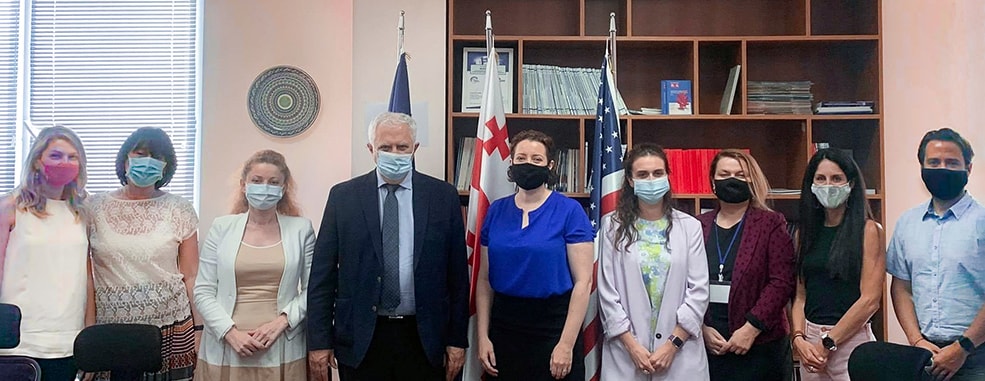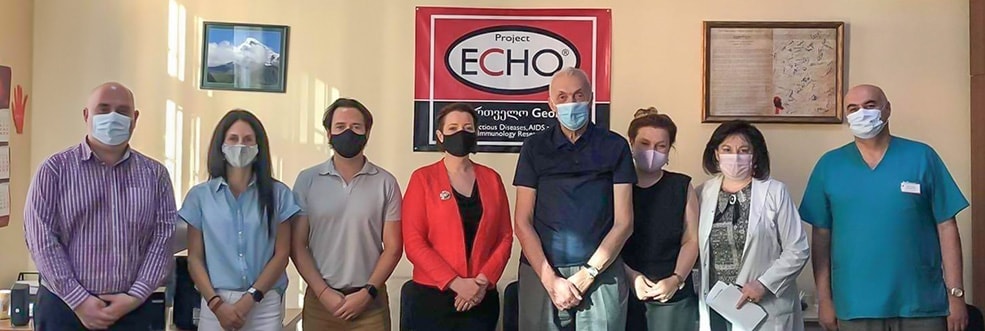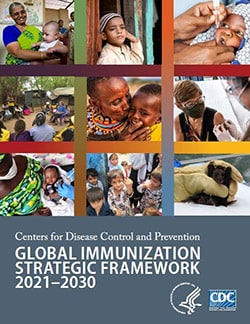
World Hepatitis Day — July 28th
Learn more about World Hepatitis Day and how viral hepatitis impacts millions of people worldwide.
World Hepatitis Day (WHD) is recognized annually on July 28th, the birthday of Dr. Baruch Blumberg (1925–2011). Dr. Blumberg discovered the hepatitis B virus in 1967, and 2 years later he developed the first hepatitis B vaccine. These achievements culminated in Dr. Blumberg winning the Nobel Prize in Physiology or Medicine in 1976. Organizations around the world, including the World Health Organization (WHO) and CDC, commemorate WHD to raise awareness about viral hepatitis, which impacts more than 354 million people worldwide. WHD creates an opportunity to educate people about the burden of these infections, CDC’s efforts to combat viral hepatitis around the world, and actions people can take to prevent these infections.
Viral hepatitis — a group of infectious diseases known as hepatitis A, hepatitis B, hepatitis C, hepatitis D, and hepatitis E — affects millions of people worldwide, causing both acute (short-term) and chronic (long-term) liver disease. Viral hepatitis causes more than one million deaths each year. While deaths from tuberculosis and HIV have been declining, deaths from hepatitis are increasing.
The vision of CDC is to eliminate viral hepatitis in the United States and globally. CDC collaborates with international partners to help countries experiencing high rates of infection to prevent, control, and eliminate viral hepatitis.
Stories from the Field: CDC Collaborates with the Country of Georgia

CDC representatives meet with Dr. Amiran Gamkrelidze (Director) and other leadership at the National Center for Disease Control and Public Health in Georgia to discuss the Hepatitis C Elimination Program. (June 2021)
Beginning in 2015, CDC partnered with the country of Georgia to launch the first Hepatitis C Elimination Program in the world. In 2019, Georgia was designated the first-ever EASL International Liver Foundation Center of Excellenceexternal icon in viral hepatitis elimination.
In June 2021, CDC and the National Center for Disease Control and Public Health, Tbilisi, Georgia (NCDC) conducted training and launched the second nationwide hepatitis B, hepatitis C, and COVID-19 serosurvey. The field work was completed in October 2021 and results show a 67% reduction in HCV infection since 2015. Information from this survey will guide ongoing efforts to meet viral hepatitis elimination targets. CDC’s international work helps reduce disease burden globally, including for overseas travelers and those migrating to the United States.

CDC works closely with the Infectious Diseases, AIDS & Clinical Research Hospital in Tbilisi, Georgia. (June 2021)
Global Hepatitis Work in Other Countries
To further decrease the burden of all types of viral hepatitis, CDC also helps countries build capacity for surveillance, testing, care, and treatment and assists with development and implementation of national control and elimination programs. CDC has recently supported other countries, including Pakistan, Uzbekistan, and Tanzania.
Learn more about CDC’s work to prevent hepatitis B globally.
CDC Global Immunization Strategic Framework
In 2021, CDC released the Global Immunization Strategic Framework 2021-2030, which provides a roadmap to achieving progress toward a world where everyone is protected from vaccine-preventable diseases (VPDs), such as hepatitis A and hepatitis B.
Three Goals are core immunization program capacities that CDC seeks to strengthen:
- Prevent VPDs by strengthening immunization services.
- Detect VPDs by supporting and improving disease surveillance systems.
- Respond to and prepare for VPD outbreaks.
Two Goals are cross-cutting capacities:
- Sustain immunization program capacities over time.
- Innovate to increase immunization program impact through research and evaluation.
Get Involved
Check out the World Hepatitis Alliance’sexternal icon (WHA) World Hepatitis Dayexternal icon website to help make sure the world knows that Hepatitis Can’t Wait. The WHA has customizable campaign resourcesexternal icon in a variety of languages, and ideas for ways you and your organization can get involved.
Join us on Social Media
Follow @cdchep on Twitter for more information about all types of viral hepatitis, and use #WorldHepatitisDay to join the conversation and spread the word.

What are the different types of hepatitis occurring around the world?
The five hepatitis viruses – hepatitis A, hepatitis B, hepatitis C, hepatitis D, and hepatitis E – are distinct and can spread in different ways, affect different populations, and result in different health outcomes.
Hepatitis A is a vaccine-preventable liver infection caused by the hepatitis A virus (HAV). HAV is found in the stool and blood of people who are infected. Hepatitis A is very contagious. It is spread when someone unknowingly ingests the virus — even in microscopic amounts — through close personal contact with an infected person or through eating contaminated food or drink. Symptoms of hepatitis A can last up to 2 months and include fatigue, nausea, stomach pain, and jaundice. Most people with hepatitis A do not have long-lasting illness. The best way to prevent hepatitis A is to get vaccinated.
Hepatitis B is a vaccine-preventable liver infection caused by the hepatitis B virus (HBV). Hepatitis B is spread when blood, semen, or other body fluids from a person infected with the virus enters the body of someone who is not infected. This can happen through sexual contact; sharing needles, syringes, or other drug-injection equipment; or from mother to baby at birth. Not all people newly infected with HBV have symptoms, but for those that do, symptoms can include fatigue, poor appetite, stomach pain, nausea, and jaundice. For many people, hepatitis B is a short-term illness. For others, it can become a long-term, chronic infection that can lead to serious, even life-threatening health issues like cirrhosis or liver cancer. Risk for chronic infection is related to age at infection: about 90% of infants with hepatitis B go on to develop chronic infection, whereas only 2%–6% of people who get hepatitis B as adults become chronically infected. The best way to prevent hepatitis B is to get vaccinated.
Hepatitis C is a liver infection caused by the hepatitis C virus (HCV). Hepatitis C is spread through contact with blood from an infected person. Today, most people become infected with the hepatitis C virus by sharing needles or other equipment used to prepare and inject drugs. For some people, hepatitis C is a short-term illness, but for more than half of people who become infected with the hepatitis C virus, it becomes a long-term, chronic infection. Chronic hepatitis C can result in serious, even life-threatening health problems like cirrhosis and liver cancer. People with chronic hepatitis C often have no symptoms and don’t feel sick. When symptoms appear, they often are a sign of advanced liver disease. There is no vaccine for hepatitis C. The best way to prevent hepatitis C is by avoiding behaviors that can spread the disease, especially injecting drugs. Getting tested for hepatitis C is important, because treatments can cure most people with hepatitis C in 8 to 12 weeks.
Hepatitis D, also known as “delta hepatitis,” is a liver infection caused by the hepatitis D virus (HDV). Hepatitis D only occurs in people who are also infected with the hepatitis B virus. Hepatitis D is spread when blood or other body fluids from a person infected with the virus enters the body of someone who is not infected. Hepatitis D can be an acute, short-term infection or become a long-term, chronic infection. Hepatitis D can cause severe symptoms and serious illness that can lead to life-long liver damage and even death. People can become infected with both hepatitis B and hepatitis D viruses at the same time (known as “coinfection”) or get hepatitis D after first being infected with the hepatitis B virus (known as “superinfection”). There is no vaccine to prevent hepatitis D. However, prevention of hepatitis B with hepatitis B vaccine also protects against hepatitis D infection.
Hepatitis E is a liver infection caused by the hepatitis E virus (HEV). HEV is found in the stool of an infected person. It is spread when someone unknowingly ingests the virus – even in microscopic amounts. In developing countries, people most often get hepatitis E from drinking water contaminated by feces from people who are infected with the virus. In the United States and other developed countries where hepatitis E is not common, people have gotten sick with hepatitis E after eating raw or undercooked pork, venison, wild boar meat, or shellfish. In the past, most cases in developed countries involved people who have recently traveled to countries where hepatitis E is common. Symptoms of hepatitis E can include fatigue, poor appetite, stomach pain, nausea, and jaundice. However, many people with hepatitis E, especially young children, have no symptoms. Except for the rare occurrence of chronic hepatitis E in people with compromised immune systems, most people recover fully from the disease without any complications. No vaccine for hepatitis E is currently available in the United States.
